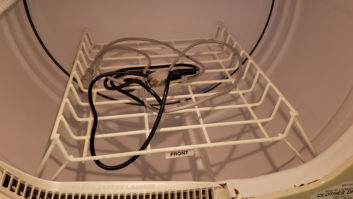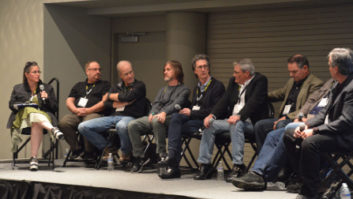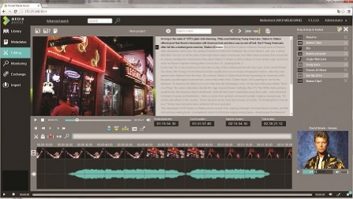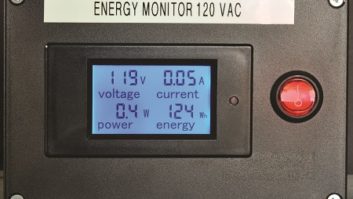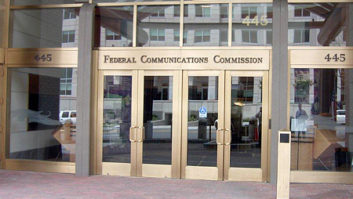Working for Belden, I get emails regularly from people who are “testing” speaker cables. I am happy to send them samples to listen to. I make it very clear, though, that our company doesn’t “listen” to anything except the customer.

‘You’ve been listening to … car jumper cables!’ Bill Hubbard and Bob Surette at the demo.
credit: Courtesy Linda Baun So it doesn’t surprise me that many high-end audio folks say that these “standard” cables can’t be very good because they are too cheap. I would agree with this at least in one way: If you paid $10 a foot for your speaker cables, then you’d better hear a difference.
Listen closely
Three years ago, I was delighted to be arm-twisted into helping my friend Gary Mach, retired chief engineer of the University of Wisconsin-Green Bay, put on a presentation at the Broadcasters Clinic and Upper Midwest SBE Regional Meeting in Madison, Wis.
The Clinic is arranged by the Wisconsin Broadcasters Association and Chapter 24 of the Society of Broadcast Engineers; it’s on my list of the most influential local broadcast shows. I try very hard not to miss it. A very good show in New York was being held at the same time that year, and I had been invited to go to China on business; but, no, I told them all, I had to go to Madison, Wis.
For Gary’s presentation, I was just the “color” commentator and didn’t really help. But they wanted me because they intended to test seven kinds of speaker cable.
Gary brought a nice pair of JBL 4310 speakers driven by a Crown XLS 202 power amp, with source material coming from a Sony RCD-W500C CD-recorder/player. Volume was controlled through a Behringer MXB-1002 mixer.
He played part of “Rodeo” by Aaron Copland, as performed by the Dallas Symphony Orchestra, and a piece of John Philip Sousa’s “The Stars and Stripes Forever,” played by the Washington Winds. Both of these pieces were “audiophile” recordings.
The crew — Bob Surette of Shively Labs and Bill Hubbard of UW-Green Bay — changed out six-foot lengths of cables while the audience of about 70 people listened, again and again, taking notes, unaware of which cable was being used.
At the end, we revealed what types of cables the audience had been listening to. There were:
Belden 8477 12 AWG speaker cable
Belden 8782 24 AWG zip cord
Romex house wiring
Car jumper cables
Barbed wire
300-ohm antenna twin-lead
3/8-inch steel hanging cable
And the winner was … 300-ohm twin-lead.
Yes, that was voted the best-sounding cable by the audience.
Second place? The car battery jumper cables. Talk about low resistance! Think of the slew rate! Damping factor!
The actual large-gage Belden speaker cable came in second — from the bottom.
(I was especially happy to see that barbed wire was included in the test. I once saw a demo at a tradeshow showing 10 base-T, or 10 megabit-per-second Ethernet, running down four pieces of barbed wire. And now I had seen it run as speaker cable. I told the audience I thought the barbed wire might have sounded a little “sharp.” The crew mentioned that barbed wire had significant skin effect, since there were often pieces of skin left on the cable.)
Good enough
Now anyone who is even vaguely connected to the high-end community would point out that this was not a double-blind test. In a big convention hall, acoustics are not ideal. And surely nobody was in the “sweet spot” for the speakers. In that way, this was not “critical listening” to any extent.
But still. A professional crowd essentially was not able to tell “good” cables from “bad” cables. Pretty much anything that gave us continuity worked well enough.
Besides, where would you go to buy 300-ohm twin-lead? Maybe that’s why we stopped making it. … We’re jacking up the price because it’s the world’s greatest speaker cable. And that twin-lead, at 300 ohms, sure had low capacitance (less than 5 pF/ft. in many designs).
Hey, maybe … I’ll get back to you!
The Broadcasters Clinic is Oct. 9–11 this year. Visit www.wi-broadcasters.org.
Steve Lampen, 2011 SBE Educator of the Year, is a technology manager and product line manager – entertainment products for Belden. His book “The Audio-Video Cable Installer’s Pocket Guide” is published by McGraw-Hill. Reach him at [email protected].






